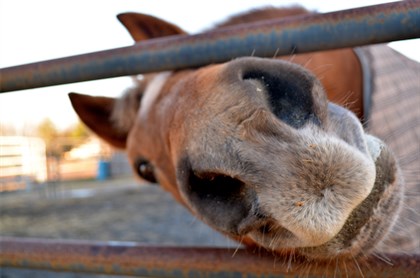|
This article has appeared previously with Equestrian Life. To see what's in our latest issue, click here.

As we come into Summer, our horses’ weight should be carefully monitored.
© Five Furlongs
Feeding the horse or pony with a propensity to become overweight easily is always a big challenge. If not paid due attention, it can lead to health problems such as laminitis and Equine Metabolic Syndrome.
BY DAVID NASH
AS MENTIONED IN my previous articles, we always look to manage the horse individually and hence treat their diet the same way.
You may have several horses on your property and they may be the same size, weight, and be undergoing the same exercise regime, however, their weight and condition may be vastly different on the same feeding regime.
This may be due to breed, (Warmbloods, Western horses such as Quarter Horses and Draught crosses seem to metabolise their energy more efficiently than other breeds such as Thoroughbreds), metabolism, behavioural demeanour and environment are just a few factors. As such the energy “calories” content of a horse’s diet must be controlled so a healthy condition score is maintained.
Monitoring of the diet is extremely important, and knowledge of what you are feeding - both from the bucket and from the ground, such as pasture and hay - is even more so. At the time of this article being compiled, we are looking at the end of summer and heading into autumn. As a result, many of our horses are relying mostly on feed from us, and some lower quality dry pasture. When the autumn break arrives we will get a spike in pasture production and hence the available “energy” from pasture will be more abundant. If we do not control this we may see a dramatic increase in the condition of our horse, or worse, in cases where horses are predisposed, such as to laminitis, or founder.

Areas of the horse evaluated for fat deposits when estimating a horse's body condition score.
Planning ahead of the spring or autumn breaks assists in reducing potential complications in terms of pasture availability. It is helpful to have dry lots, that is, areas with little to no pasture, for horses to range on with a low ability to consume large amounts of pasture.
Pasture muzzles also are another option to reduce pasture feed intake, as well as slowing down the rate of intake, which is just as important with regards to glucose metabolism and horses suffering from Equine Metabolic Syndrome (EMS).
If a “dry lot” situation or grazing muzzles are not an option, an alternative is to encourage horses to consume lower energy pasture/cereal hay rather than the pasture. To even further reduce the energy/sugar content of the feed, soak the hay for 30-60 minutes, rinse the water out, and feed out in a double haynet to reduce consumption rate.
I have seen many people advertising “low sugar” pasture hay. If you are going to purchase this hay, it is mandatory to ask for a feed test. A NSC (non-structural carbohydrate) level should be below 10-12%. This hay should be ideally mature grass. As the pasture elongates, the sugar levels will reduce. Whilst not ideal for dairy cattle, this type of hay is ideal for horses requiring low-calorie diets and that are at risk from metabolic disorders.
A common misconception of feeding obese or fat horses is to reduce their intake of feed dramatically. Doing so can lead to many problems, such as malnutrition and colic, and gastric problems such as ulcers. The horse evolved as a ranging herbivore so its digestive system is designed to eat small feeds frequently. Dramatically reducing the amount of feed (volume), changes the amount of energy consumed as desired, however, it does not take into account the minimum amount of feed that an animal requires for a healthy digestive system, as well as to keep a healthy gut microbial population.

Certain breeds tend to metabolise their energy more efficiently.
© Andy Piper
Another problem that arises when we dramatically cut the amount of feed we give a horse in order to maintain or reduce weight, is that our nutrient ratios and amounts will change. If we simply reduce the amount of the same feed, whilst not readjusting the type of feed or nutrient concentration, we can lead to under-supplying nutrients such as protein, minerals and vitamins which are essential for maintaining the health of the horse. When reducing the caloric intake of your horse, it may be wise to consult a nutritionist, or even use some of the online ration evaluators, to assist in rebalancing your horse’s diet.
You may find that rebalancing your horse’s diet with a lower energy roughage source, along with appropriate supplements for other nutrients such as protein, vitamins and minerals, will maintain your horse’s condition in a healthy state and will also assist in maintaining a target condition for your horse.
READ THE LATEST NEWS ARTICLES HERE

|

